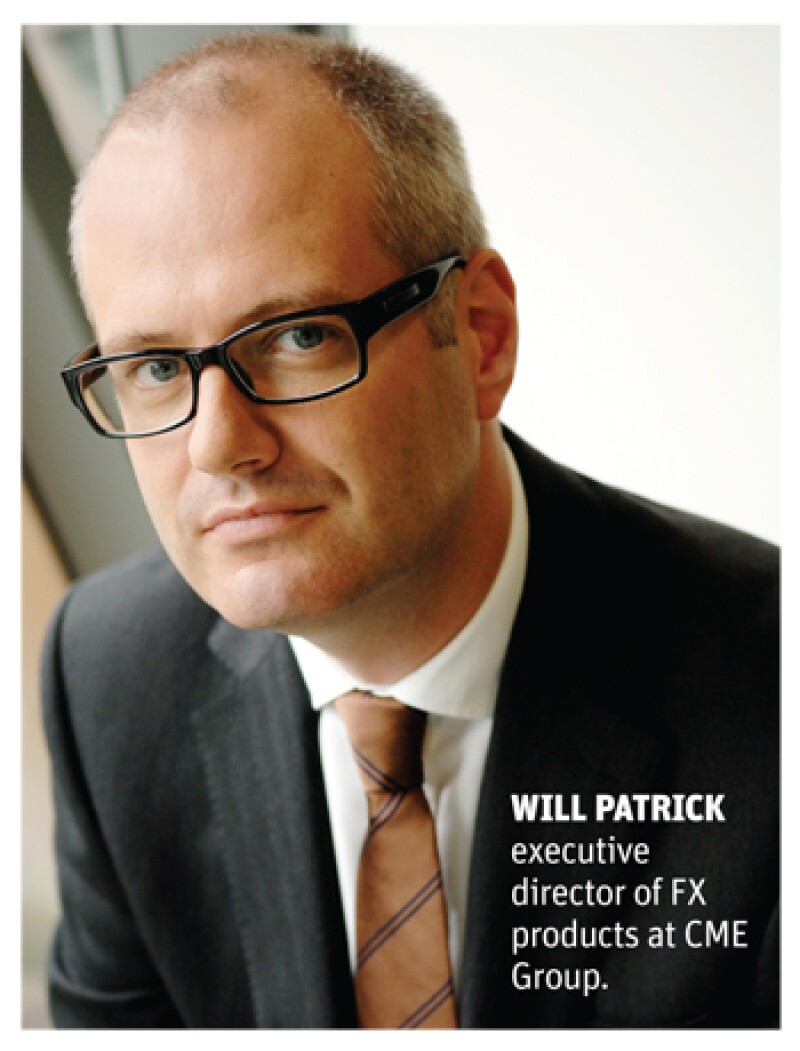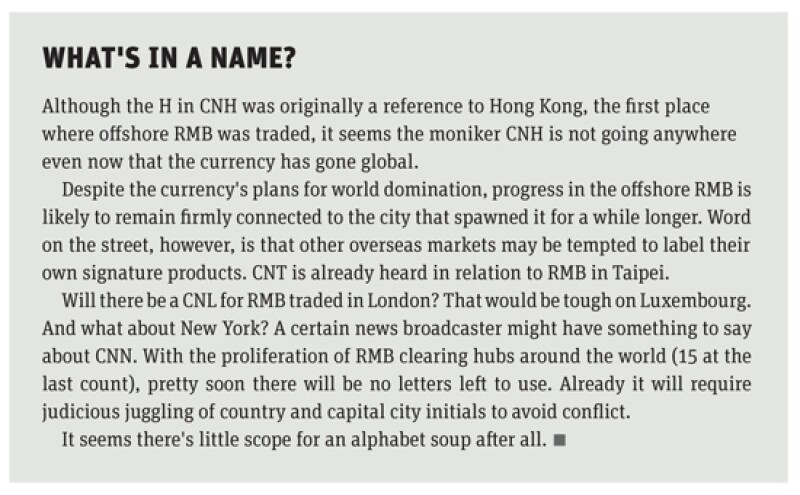Put aside the big picture for a moment. Until 2012, if you were a Chinese company that needed to pay a commodity seller in Brazil in its local currency, you were faced with two main options. One was to go to your trusted bank branch and initiate a fund transfer. This route typically involved getting some stamps, ensuring you had the required approvals from the State Administration of Foreign Exchange (Safe) to convert domestic currency into foreign funds, then waiting for a couple of days for the bank to process your payment.
If the length and bureaucratic nature of that process were not enough hassle, your trusted local banks would typically charge you a double fee to cover the conversion of renminbi into dollars and then dollars into Brazilian reais. All in all, unappealing.
Hence the second option. You called up your agent on his mobile and set up the transactions. Your agent then received a bank transfer from you in China in onshore currency (CNY). On the same day, a Hong Kong-based friendly business partner of your agent would make another fund transfer from a Hong Kong account to Brazil – giving the counterparty the option of receiving offshore RMB (CNH) or another currency.
As anyone who has ever done a bank transfer in Hong Kong knows, the whole ordeal would not take more than a few hours and, in a liquid FX market such as the one in Hong Kong, would all but guarantee substantially cheaper spreads.
The magic was that capital had never physically moved out of China. Your Brazilian counterpart would not care about that, however, as long as the payment was received smoothly and efficiently. You, on the other hand, would have been cautious. Such practices were tax-free, and could be illegal.
China has since liberalised its current account to allow all domestic import and export enabled businesses to trade in RMB without the need for prior registration. But despite the progress, obstacles and hefty costs remain for onshore businesses engaged in cross-border activities.
New players in town
Frazer McRae worked for eight years with Bank of America Merrill Lynch in FX and interest rates derivatives trading. He has since left to launch a start-up called Mercury FX. The new business, through a unique partnership agreement with Guangzhou Unionpay, offers same-day, low-cost spot FX services to companies that are selling to or buying from Chinese parties and need to convert RMB-denominated payments in their own currency, as well as servicing those looking to make quick and inexpensive transfers from onshore to offshore.
This service — the first by a non-bank entity to pioneer cross-border RMB services in a fully compliant and approved product — would have been impossible until just a few years ago given China’s capital controls affecting the movement of its currency. But it is now a viable business model on the back of regulations that have liberalised current account payments of any amount.
These reforms, more broadly, speak of a high-level policy agenda set in Beijing aimed at liberalising the Chinese markets and letting the red-back – as the RMB is also known – run off into the big wide world. Of course, a globalised RMB remains still a theory. In practice, offshore RMB still operates as a separate currency from its onshore counterpart.
For McRae, the effect of these liberalisation efforts will be to both legalise and tax the massive portion of China’s shadow banking industry that currently specialises in the movement of capital from onshore to offshore, originally just for trade but increasingly for investment purposes.
“We wanted to do a product that was better than the banks'," he says. "Then we found out that a lot of the FX business went to the shadow banking sector. It is fantastic, very efficient, cost-effective. The only problem is that it’s illegal. It’s an advanced peer to peer system and the volumes are astronomical. Companies use it heavily."
As a result, having any chance of success relied on the ability to not only compete with established banks but also with the shadow banking sector players that offer wire transfer-like services. The partnership with Guangzhou UnionPay, an onshore giant in the payment landscape, and the reliance on an all-electronic platform, allows the start-up to offer a competitive proposition.
“To compete we had to reinvent the settlement system to reach same day settlement," adds McRae. "We can do that now and we are on par with the pricing, as we have some arbitrage with onshore/offshore FX rates.”
The big bucks
The more high-brow debate around the potential for the RMB to become the next global reserve currency is translating into very real business strategies being reformulated around the globe. This applies to new entrants like Mercury FX, but the shift is even more crucial for heavyweight market players in the foreign exchange markets.
“The advent of the CNH is in itself a once in a lifetime event for the FX market, as a new currency being created is an extremely rare occurrence,” says Simon Winn, head of sales, Asia Pacific, for EBS, the electronic FX business arm of ICAP.
EBS is one of the largest FX trading platforms in the world, churning some $130bn of spot FX transactions across all currency pairs each day. In mid-January it announced a strategic partnership with the Singapore Exchange, where products such as CNH futures are becoming popular.
The purpose for EBS in combining forces with SGX, Winn says, is to offer a consolidated choice of trading to clients that reflects market liquidity and the regulatory environment. “Greater liquidity provides transparency, spread compression and ultimately lowers transaction costs, which will benefit all clients,” he adds.
This is all the more important as the CNH FX market in Asian time zones dominates some 60% of total trading, says Winn, with 35% in Europe and only some 5% in the US.
London reported in December 2014 that average daily volumes (ADV) for the first half of 2014 across deliverable and non-deliverable offshore RMB products was $54bn. Hong Kong added another $30bn ADV by the end of 2014 between spot and forward transactions, and Singapore traded $31bn ADV as of December 2013 — and has seen a further leap forward since the launch of RMB futures in October 2014.
The Bank for International Settlements (BIS) estimates that, as of April 2013, global RMB FX activity was in the region of $120bn ADV.
In the increasingly sizeable USD/CNH market going through electronic platforms, EBS has become a force to be reckoned with. Winn says that from 5% of the electronically traded CNH market at the end of 2013, EBS now corners some 50% market share — and this is growing. However, it is far from the only player benefiting from the seismic change brought about by the rise of the RMB as an international currency.
CME Group runs the world’s largest derivatives marketplace. It reported in early April 2015 that trading for the first quarter of 2015 across products had reached an average of 15m contracts per day, with 1m in FX. Average daily notional value for FX contracts was $112m. CME already offers CNH futures, which it launched at the end of February 2013, with over 900 contracts traded in March 2015.
Those contracts, which are typically based on the USD/CNH currency pair, are used for a variety of purposes, such as hedging of trade finance transactions or to hedge currency risks for qualified foreign institutional investors (QFII) that trade in Chinese A-shares and will be converting gains or losses into dollars.

CME executives say that the market has seen explosive growth in RMB business. “From an Asian perspective, we have seen the immense growth of liquidity and internationalisation of the OTC participation in CNH — it’s been tremendous,” says Malcolm Baker, senior director of FX and interest rate products at CME Group.
CNH products have been growing not only in terms of sheer trading volumes but also in terms of their geographical appeal. “The CNH is not as liquid as the euro or yen, but it is on the way there and, at times, it is as liquid [as euro or yen] in the Asian time zone,” Baker adds.
“Interestingly though, if you look at two years ago, 80% of OTC CNH was traded in the Hong Kong trading zone. Now, 60% to 70% of CNH trading happens between early afternoon Hong Kong to just after lunch London time. These are the main trading hours for many currencies. CNH is trading like a global currency, it has lost its ‘emerging markets’ name.”
The proof being in the eating, Baker noted that around February-March 2014, levels were around $50bn daily, but that trading of CNH-denominated contracts had since surged. “A major OTC participant was guesstimating the market was now north of $100bn-$200bn across spot, short term swaps, and options transactions” he says.
Aiming for the top
Will Patrick, executive director of FX products at CME Group, adds that the RMB has shown the scope to join the top five most traded currencies in the FX markets. “Our expectations are that in short term we would like to see it as a top 10 currency in spot and futures on CME Group,” says Patrick. “And then among the top five currencies — we think it’s got that potential.”
As of 2013, according to the BIS, the RMB was the ninth most traded currency in the FX markets, with 2.2% of market share, light years behind the dollar, which held 87%.

Hints of the RMB’s popularity can be found beyond the hard numbers. Another indicator of the maturity of the currency is a growing diversity in the client base, which has now evolved well beyond simple trade-related business. “In the OTC market we are certainly seeing a large proportion of all types of banks in CNH trades,” says Baker.
“In other segments, we see commercial transactions, large currency hedges from commercial groups and corporates. Hedge funds that I speak to are trading CNH too. And of course the retail market is huge, whether from Taiwan, Hong Kong, Singapore. There is an overwhelming belief in buying CNH there.”
Looking ahead, liquidity in the CNH market remains a target. “We are focused on getting more liquidity in our [CNH] contracts to see growth in line with the international volumes, as well as tightening the spreads,” says Patrick. “We also want to make sure our clients can access the market 23 hours a day.”
CNY+CNH=RMB
Full liberalisation of the RMB, which would effectively merge the CNH and the CNY markets, remains the apparent policy direction. The 2015 National People’s Congress saw an explicit commitment by China’s top brass to achieving full convertibility by the end of the year. Banks such as HSBC have noted that this signals more reforms on the way, with a realistic target of a full opening within two years.
Players such as EBS are expecting some of these upcoming reforms to take place in China’s rapidly multiplying pilot free trade zones. Winn believes the proliferation of the onshore pilot zones — with three new ones just launched in Guangdong, Fujian and Tianjin — hints at a broader strategy.
“There is an argument that with the number of FTZs being set up, they can create an ‘onshore-offshore’ market with the CNH, but retain a control on capital account with the CNY in the background by controlling the fixing,” says Winn. He adds that such a reform would effectively open the capital account within China itself, while preserving some degree of the government’s control on the currency.
It remains to be seen how quickly and how radically China’s echelons will move to make the RMB a more freely or even fully tradeable currency. In the shorter term, a topic of wide discussion is the expansion of the RMB’s trading band.

The currency has moved from a near-peg to the dollar and a managed floating exchange rate regime, to an increasingly looser regime based on a basket of currencies. The currency has, since March 2014, been allowed to trade 2% up or down from the daily fixing, with a limit on the spread between RMB/USD buying and selling prices offered by designated foreign-exchange banks to their clients also removed by the People’s Bank of China (PBoC).
Market participants increasingly share the view that, along with further interest cuts, a possible increase of the trading band to 3% or 4% is on the cards for this year. The PBoC has underlined in a recent paper that exchange rate regime reform will continue in a somewhat typical Chinese fashion.
“The RMB exchange rate regime will be further improved to allow market demand and supply to play a greater role, to enhance two way flexibility of the RMB exchange rate, and to keep the exchange rate basically stable at an adaptive and equilibrium level,” the PBoC wrote in a quarterly report in February.
Reforms on the CNY will no doubt be reflected in the CNH, with a greater market role bound to increase interest in the currency. The global RMB party is just getting started.
